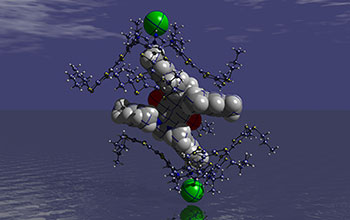Multimedia Gallery
Electron Switch Between Molecules (Image 3)
The development of new organic batteries--lightweight energy storage devices that work without the need for toxic heavy metals--has a brighter future now that chemists have discovered a new way to pass electrons back and forth between two molecules. In this illustration, an assembled set of different molecules meet, exchange electrons and then disassemble because chloride ions--represented here as green spheres--are present. If these chloride ions are removed, the entire process can be reversed.
More About This Image
The research was led by University of Texas at Austin chemists Christopher Bielawski and Jonathan Sessler, with additional support from graduate student Jung Su Park, who grew crystals of the two molecules.
When molecules meet, they often form new compounds by exchanging electrons. In some cases, the electron transfer process creates one molecule with a positive charge and one molecule with a negative charge. Molecules with opposite charges are attracted to each other and can combine to form something new.
In their research, the chemists created two molecules that could meet and exchange electrons but not unite to form a new compound. The molecules were "spring-loaded" to push apart after interacting with each other. "After electron transfer occurs, two positively charged molecules are formed which are repelled by each other, much like magnets held in a certain way will repel each other. We also installed a chemical switch that allowed the electron transfer process to proceed in the opposite direction," said Bielawski.
Not only does this system give important clues for making an efficient organic battery, but, Bielawski says, understanding the electron transfer processes in these molecules provides a way to design organic materials for storing electrical energy that could then be retrieved for later use.
To read more about this research, see the UT news story Electron Switch Between Molecules Points Way to New High-Powered Organic Batteries. [Portions of this research (i.e., X-ray diffractometer) were supported by National Science Foundation grants CHE 07-49571 and CHE 07-41973.] (Date of Image: September 2010) [Image 3 of 3 related images. Back to Image 1.]
Credit: Jung Su Park; Department of Chemistry and Biochemistry, The University of Texas at Austin
Images and other media in the National Science Foundation Multimedia Gallery are available for use in print and electronic material by NSF employees, members of the media, university staff, teachers and the general public. All media in the gallery are intended for personal, educational and nonprofit/non-commercial use only.
Images credited to the National Science Foundation, a federal agency, are in the public domain. The images were created by employees of the United States Government as part of their official duties or prepared by contractors as "works for hire" for NSF. You may freely use NSF-credited images and, at your discretion, credit NSF with a "Courtesy: National Science Foundation" notation.
Additional information about general usage can be found in Conditions.
Also Available:
Download the high-resolution JPG version of the image. (671 KB)
Use your mouse to right-click (Mac users may need to Ctrl-click) the link above and choose the option that will save the file or target to your computer.



